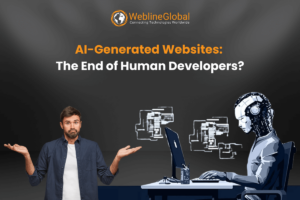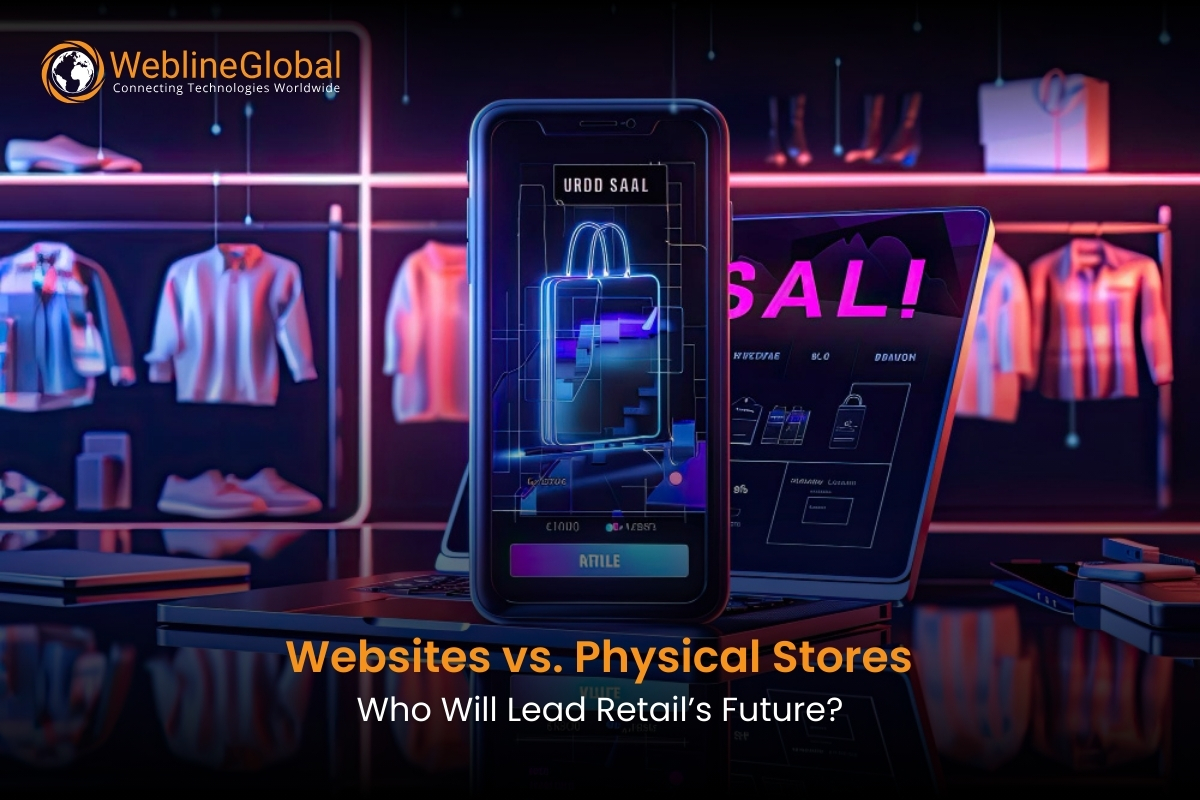
The retail industry is undergoing a seismic shift. For decades, the brick-and-mortar store reigned supreme. Customers enjoyed the tactile experience of browsing shelves, interacting with staff, and physically holding products. However, the rise of the internet and the proliferation of mobile devices have dramatically altered consumer behavior.
Today, more and more, shoppers are turning to online platforms for their purchasing needs, leading many to question the future of traditional retail. The two major questions are:
- Is this the end of the physical store as we know it?
- Is a retail website the key to survival, and more importantly, thriving in the modern retail market?
This blog post will delve into these questions, exploring the challenges and opportunities presented by this digital transformation, and examining the critical role of website development in shaping the future of retail.
The Decline of Brick-and-Mortar Stores
Physical retail stores have long been the cornerstone of commerce, offering a tangible shopping experience that customers have cherished for decades. However, the rise of the internet and the widespread adoption of smartphones have shifted consumer behavior toward online shopping.
In addition, traditional brick-and-mortar stores are facing significant challenges, including increased operational costs, changing consumer preferences, and a global pandemic that forced many stores to close their doors temporarily.
Is Your Retail Business Losing Customers Without a Website?
Changing Consumer Behavior
In recent years, consumers have embraced the convenience of online shopping, where they can browse through vast product selections from the comfort of their homes. Website development plays a critical role in this shift, as businesses seek to create seamless and user-friendly online shopping experiences. With the click of a button, customers can compare prices, read reviews, and make purchases at any time of day, eliminating the need to visit physical stores.
- 24/7 accessibility: Online shopping is available around the clock, allowing consumers to shop whenever they want.
- Endless product variety: Retailers can offer an extensive catalog of products without the constraints of physical space.
- Convenience and comfort: Customers can shop from anywhere, saving time and effort.
Operational Costs
Running a physical store requires significant expenses, such as rent, utilities, insurance, and staffing. These costs can be burdensome for businesses, particularly small or startup retailers. Web development offers an attractive alternative by reducing overhead costs. A website allows businesses to operate without the need for a physical storefront, providing them with the flexibility to expand their reach while keeping operational costs manageable.
- Reduced overhead: With no need for a physical location, businesses can allocate resources toward improving their online platforms.
- Global reach: Retail website development enables businesses to reach customers worldwide, opening up new markets without the expense of physical expansion.
Impact of the Pandemic
The COVID-19 pandemic forced many brick-and-mortar stores to temporarily shut down, leaving businesses no choice but to pivot to online operations. During this period, retailers with well-developed websites experienced a surge in sales, while those reliant on physical stores faced devastating losses. This shift accelerated the need for businesses to invest in retail website development, ensuring they could continue operating during times of crisis.
- E-commerce growth: The pandemic prompted an explosion in e-commerce as people turned to online shopping to meet their needs.
- Digital transformation: Retailers realized the importance of adapting to the digital age by developing robust online platforms.
The Rise of eCommerce and the Importance of a Strong Online Presence
International Trade Administration reveals some impressive statistics about B2B and B2C eCommerce markets worldwide. The global B2C eCommerce market is projected to expand significantly, reaching a revenue of USD $5.5 trillion by 2027, driven by a consistent compound annual growth rate (CAGR) of 14.4%. The top-performing sectors in B2C eCommerce, ranked in order, include consumer electronics, fashion, furniture, toys and hobbies, biohealth pharmaceuticals, media and entertainment, beverages, and food.
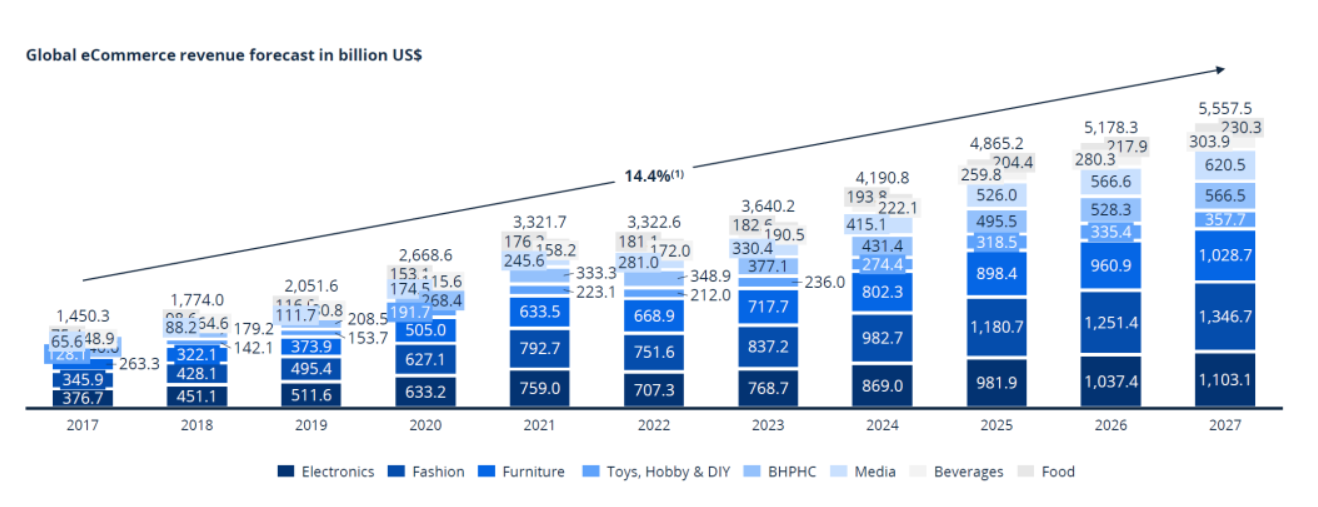
On the other hand, Trade.gov also reports that global B2B eCommerce sales have experienced consistent year-over-year growth over the past decade, with the market expected to reach a valuation of USD $36 trillion by 2026. Key sectors driving the majority of this B2B sales value include heavy industries such as advanced manufacturing, energy, healthcare, and professional business services.
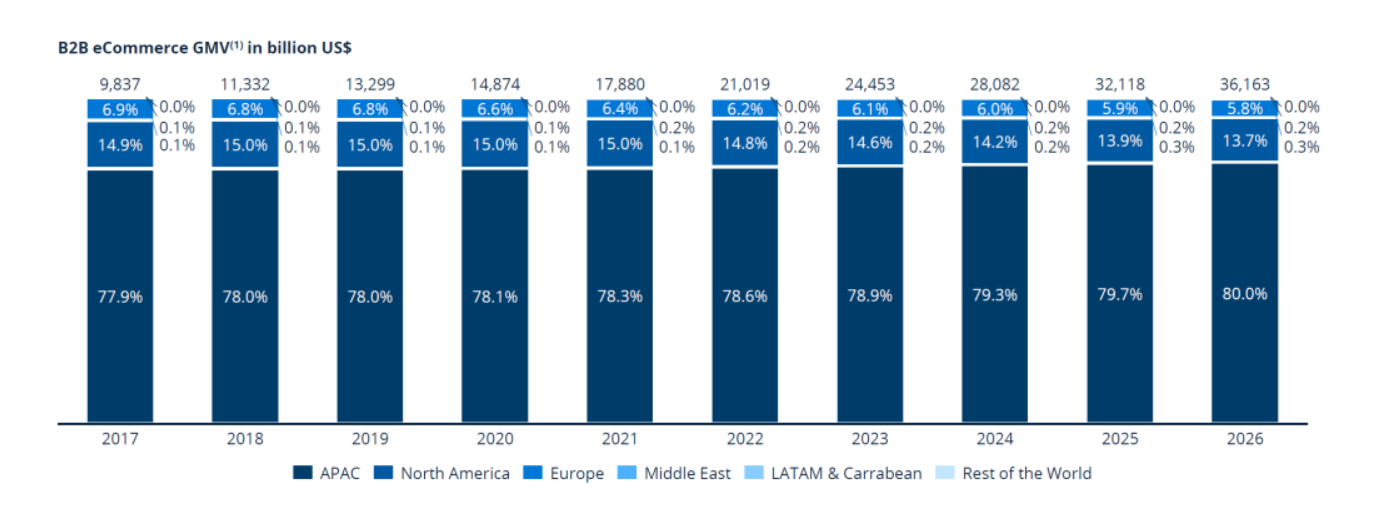
All these figures and statistics reveal that in the digital age, a strong online presence is paramount for any retail business. A website serves as a virtual storefront, accessible to customers 24/7. It provides a platform to showcase products, share information about the company, and engage with customers.
A professional and user-friendly website is crucial for building brand credibility and attracting new customers. It also allows businesses to expand their reach beyond geographical limitations, tapping into a global market.
Additionally, a website can be a powerful tool for customer retention. Through email marketing, personalized recommendations, and loyalty programs, businesses can cultivate customer relationships and encourage repeat purchases. This underlines the importance of investing in professional web development services.
Need a Website That Turns Visitors into Paying Customers?
Why Website Development is Key to the Future of Retail?
As the demand for online shopping continues to rise, website development becomes essential for businesses looking to thrive in the digital marketplace. A well-designed website can provide a competitive edge, driving traffic, improving customer engagement, and increasing sales.
An article titled Role of eCommerce in our Daily Life in the International Journal of Humanities and Social Science Studies states that the rise of IT has transformed business operations in today’s competitive and technology-driven world. Strategic and efficient business practices are crucial, aiming for higher output at lower costs, which IT enables.
The journal further opines that the internet provides virtual space, reducing expenses like rent and transportation, thereby lowering product costs. E-commerce systems offer real-time data and analytics, tracking customer interactions, product interests, abandoned carts, and purchase patterns. These insights allow businesses to adapt and better meet customer needs.
Let’s see the impacting factors:
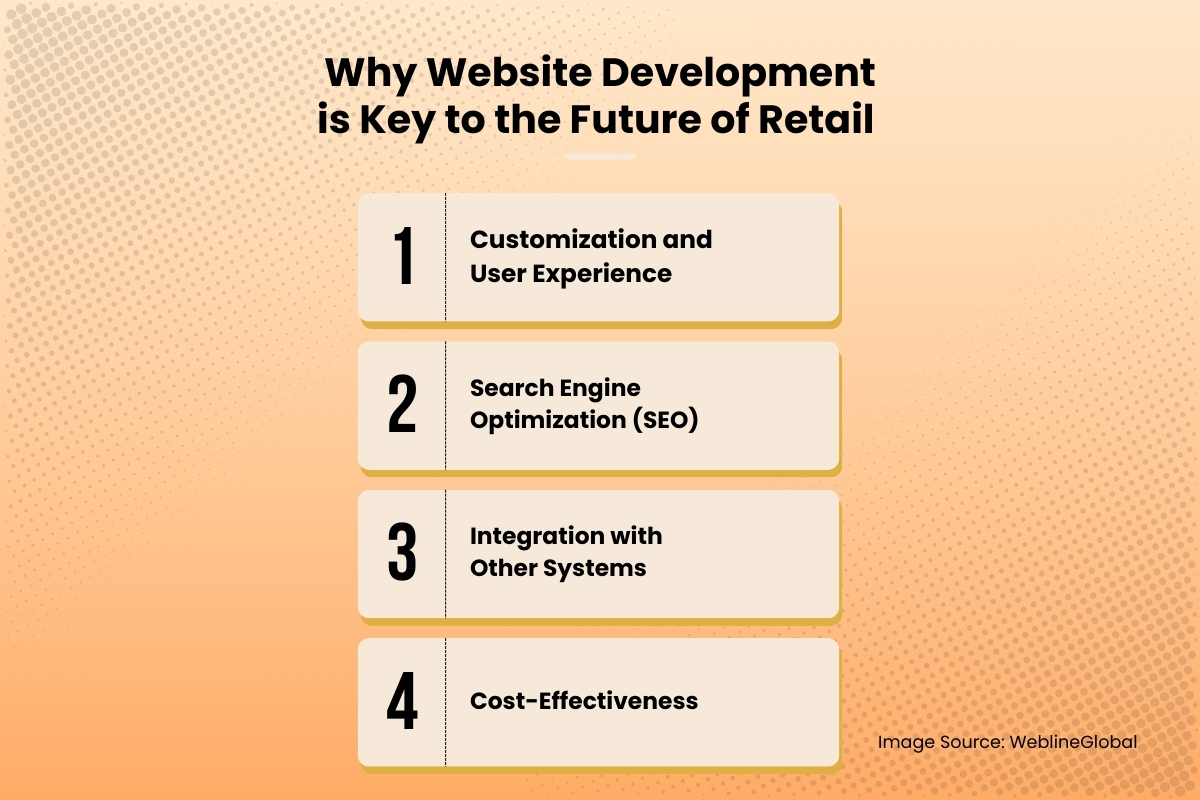
Customization and User Experience
One of the most significant advantages of web development is the ability to tailor a website to meet the specific needs of a business and its customers. From user-friendly navigation to responsive design, a customized website enhances the overall shopping experience.
Retail website development allows businesses to create a personalized experience for each customer, increasing satisfaction and encouraging repeat visits.
- Personalization: Websites can be tailored to showcase products based on customer preferences and browsing history.
- Responsive design: A well-optimized website ensures that users have a seamless experience across various devices, from desktop computers to smartphones.
- Interactive features: Implementing chatbots, product recommendation engines, and live support can significantly improve customer engagement.
Search Engine Optimization (SEO)
A website that is properly optimized for search engines is more likely to be discovered by potential customers. Web development plays a crucial role in implementing effective SEO strategies, such as optimizing keywords, improving page speed, and creating high-quality content.
When done correctly, SEO increases a website’s visibility, driving organic traffic and generating more sales.
- Keyword optimization: Using the right keywords in product descriptions, blog posts, and other content helps attract the right audience.
- Page speed: A fast-loading website improves user experience and increases the likelihood of conversions.
- Content marketing: Providing valuable and informative content helps establish the brand as an authority in its industry.
Integration with Other Systems
Modern web development enables seamless integration with various third-party systems, including payment gateways, inventory management, and customer relationship management (CRM) software. These integrations simplify business operations and ensure a smooth shopping experience for customers.
Retail website development allows businesses to automate processes, track customer data, and manage inventory more efficiently, all from one centralized platform.
- Payment systems: Integration with secure payment gateways ensures that customers can make purchases with ease.
- Inventory management: Automated systems help track stock levels, reducing the risk of overselling.
- CRM tools: Collecting customer data enables businesses to create targeted marketing campaigns and improve customer retention.
Cost-Effectiveness
Investing in retail website development can be more cost-effective than maintaining a physical store. While there are initial costs associated with developing a website, such as design, programming, and hosting, these expenses are often lower than the ongoing costs of running a brick-and-mortar store. Furthermore, the potential for growth and the ability to reach a global audience makes website development a long-term investment that pays off over time.
- Lower overhead costs: With no need for rent or utilities, businesses can allocate funds toward improving their online platform.
- Scalability: Online stores can scale quickly to accommodate increased demand, without the need for additional physical space.
Retail Website Development: Tailored Solutions for the Retail Industry
Retail website development is a specialized area of web development that focuses on the specific needs of retail businesses. A retail website should be designed to facilitate online sales, manage inventory, and process payments.
The retail website or software should also integrate with other business systems, such as CRM and ERP. Retail website development often involves the use of e-commerce platforms, such as Shopify or Magento, which provide pre-built functionality for online retail. These platforms can be customized to meet the unique requirements of each business. Investing in professional retail website development is a significant step for any brick-and-mortar store looking to transition into the digital realm.
The Future of Retail: A Hybrid Approach?
While the rise of e-commerce has undoubtedly impacted brick-and-mortar stores, it is unlikely that physical stores will disappear entirely. Many consumers still value the in-person shopping experience, particularly for certain types of products.
The future of retail likely lies in a hybrid approach, where brick-and-mortar stores and AI-powered online eCommerce platforms work together seamlessly. This omnichannel strategy allows businesses to cater to the diverse needs and preferences of their customers. For example, customers may browse products online and then visit a physical store to make a purchase. Or, they may purchase online and choose to pick up their order in-store. This integration requires sophisticated retail website development and robust back-end systems.
Key Elements of a Successful Retail Website
A successful retail website should possess several key characteristics:
- User-friendly design: The website should be easy to navigate, with clear calls to action and a simple checkout process.
- Mobile responsiveness: The website should adapt to different screen sizes and devices, ensuring a seamless experience for mobile users.
- Search engine optimization (SEO): The website should be optimized for search engines to attract organic traffic.
- High-quality product images and descriptions: Products should be showcased with professional photos and detailed descriptions.
- Secure payment gateway: The website should use a secure payment gateway to protect customer data.
- Excellent customer service: The website should provide easy access to customer support, such as live chat or email.
- Integration with social media: The website should be integrated with social media platforms to promote products and engage with customers.
The Importance of Content Management Systems (CMS)
A Content Management System (CMS) is a software application that allows users to create and manage digital content. For retail websites, a CMS is essential for updating product information, managing inventory, and creating marketing content.
Popular CMS platforms include WordPress, Drupal, and Joomla. Choosing the right CMS is crucial for ensuring that the website is easy to manage and maintain. A well-chosen CMS simplifies web development and reduces the ongoing maintenance costs of the website.
Investing in Web Development: A Strategic Imperative
Investing in professional web development is not an expense, but a strategic investment in the future of the business. A well-designed and functional website is essential for attracting new customers, increasing sales, and building brand loyalty.
A retail business website allows companies to compete in the digital marketplace and thrive in the face of increasing competition. Ignoring the importance of website development can be a costly mistake, potentially leading to lost revenue and a decline in market share.
Conclusion
The rise of online shopping and the growing importance of website development have undeniably altered the retail landscape. As brick-and-mortar stores face increasing challenges, businesses must adapt to the changing market by embracing web development and retail website development.
WeblineGlobal helps you build a well-crafted website that offers convenience, cost-effectiveness, and scalability, making it an essential tool for retailers looking to thrive in the digital age. However, a hybrid approach that combines the benefits of both online and offline shopping may be the key to the future of retail.
Social Hashtags
#RetailFuture #EcommerceGrowth #OnlineShopping #DigitalRetail #RetailWebsite #BrickAndMortar #RetailTrends #ShopOnline #RetailBusiness #WebDevelopment #OnlineStore #HybridRetail #RetailMarketing #CustomerExperience #RetailTech
Want to Build a Retail Website That Drives Sales & Growth?
